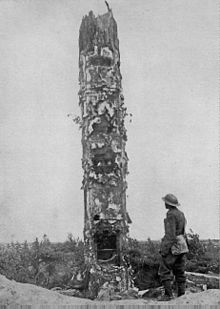Military tactics - Picture
More about World War 1

|
|
Military tactics
Warfare
Military history
Military tactics, the art of organizing an army, are the techniques for using weapons or military units in combination for engaging and defeating an enemy in battle. Changes in philosophy and technology over time have been reflected in changes to military tactics.
In current military thought, tactics are the lowest of three planning levels, involving small units up to a few hundred personnel. The highest tier of planning is the strategy, which is concerned with the overall means and plan for achieving a long-term outcome. An intermediate level, which converts the strategy (high level) into tactics (low level) is the operational level that deals with formations of units.
Concept

Picture - German World War I observation post disguised as a tree.
Military tactics are at once both a science and an art. There are basic principles which - if followed - at least lend competency, 'battle drills' which try to promote automatic responses to given situations, and dozens of guides and instructions that have been written over the centuries.
For some, tactics are instinctive. Sometimes they can be taught. At its heart, tactics is a shifting amalgam of psychology, physics, and statistics.
Some practices have not changed since the dawn of warfare: ambushes, seeking and turning flanks, maintaining reconnaissance, creating and using obstacles and defences, etc. Using ground to best advantage has not changed much either. Heights, rivers, swamps, passes, choke points, and natural cover, can all be used in multiple ways. Before the nineteenth century, many military tactics were confined to battlefield concerns: how to maneuver units during combat in open terrain. Nowadays, specialized tactics exist for many situations, for example for securing a room in a building.
What does change constantly is the technological dimension, as well as the sociology of combatants. One might wish to reflect on the differences in the technology and society that produced such different types of soldier or warrior as the Roman Legionary, the Medieval Knight, the Turk-Mongol Horse Archer, the Chinese Crossbowman, the British Redcoat, or an Air Cavalry trooper. Each, constrained by his weaponry, logistics and his social conditioning, would use a battlefield differently, but would usually seek the same outcomes from their use of tactics.
Bibliography
Rob Johnson and Michael Whitby, How to Win on the Battlefield: The 25 Key Tactics of All Time (2010)
Muhm, Gerhard. "German Tactics in the Italian Campaign". http://www.larchivio.org/xoom/gerhardmuhm2.htm.
Gerhard Muhm : La Tattica nella campagna ass d’Italia, in LINEA GOTICA AVAMPOSTO DEI BALCANI, (Hrsg.) Amedeo Montemaggi - Edizioni Civitas, Roma 1993
More aircraft.
Source: WikiPedia